Clik here to view.

Clik here to view.
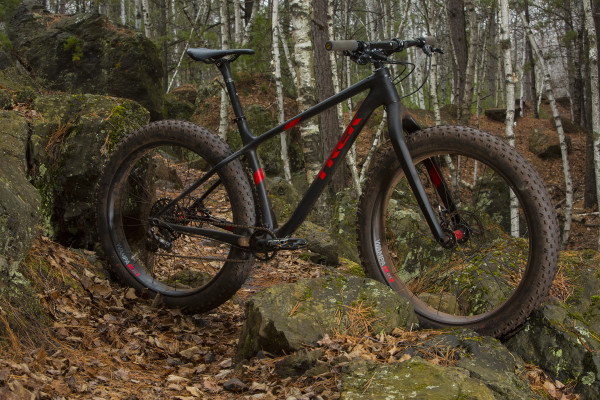
The Trek Farley 9.8 proudly stands atop Cuyuna’s iron mining rocks on the “Skip” trail.
The long-term red dirt review
Having reviewed the original baby blue Farley and now it’s cousin, the 9.8, I’d like to make the following suggestion. Let’s change the name. Farley, I get it, ok, sure. But, the direction Trek is moving this bike frame is anything but fat, slow, or a jiggly belly bouncing on a coffee table. It rolls, it’s sleek, it’s rigid, and, outside of the 3.8″ tires, it’s hardly recognizable as fat.
This is the first of two reviews. This story captures the heart and soul of riding the 9.8 on single-track dirt. The follow-up review will focus exclusively on the 9.8’s winter groomed single-track performance. Our objective is to uncover the year-round ability of the 9.8. The test Farley was a 19.5″, it’s rider is 6’0″ and 195 pounds.
The early impressions.
Taking the frame, fork, and wheel set out of the box I realized quickly the high amount of engineering firepower that went into the creation of this bike. Parts easily fell in line with their mating part. It was like a puzzle, but a puzzle that felt like placing pieces of museum quality carbon together. At no point did something not quite fit together. It was seamless, gorgeous, and glorious. “Wow” was a frequent word of choice as the bike began to take shape.
Another positive takeaway in the early minutes with the 9.8 was when I picked up the fork and steerer tube. When I picked up the original Farley’s fork my jaw dropped with how heavy it was. That memory was still firmly in my mind when I grabbed the 9.8 fork and I was gladly surprised to have a feather-weight in my hand. Well done Trek, great enhancement.
Trek doesn’t clearly tip their hand about, who this bike is made for, but from my assessment the Farley 9.8 is a contender for the person who wants to buy one bike, and ride it year round. For a person who wants the lightest possible year round bike, and a person who is excited about being able to change wheels sets based on the trail conditions. Believe it or not, in Minnesota, I’d consider this a great asset. In the winter I change tires weekly if not daily based on the snow conditions. Having the ability to add wheel sets to that mix provides added appeal. Having the added bonus of being able to go from 29+ to 27-Fat to 26-Fat is a real charmer if you are buying one bike, for all 12 months. (keep in mind, you might want multiple wheel sets)
The Farley 9.8 is a carbon masterpiece. Seriously, if there was a museum for fat-bikes, this bike would be the star attraction along that hall. It’s a “spare-no-expense” equipping of Trek’s OCLV mountain carbon frame with the first-class components to build up a spec list that is hard to match. Every component choice (outside of the stem) looks to be selected to shave weight and increase the visual design/aesthetics.
Components that stand out are the RaceFace Next SL carbon cranks and the 27.5″ tubeless ready Wampa carbon fat rims. Having switched to carbon rims on my personal fat-bike last year, it’s a major evolution forward from a “crawler” fat bike to a “rock and roll” fast bike. In short, this bike is one stunning plate of eye candy. It looks good, but how does it ride?
THE DIRT RIDE EXPERIENCE:
Uphill.
It was immediate recognizing the 9.8’s ability to roll uphill. It wasn’t 100% better than any other bike I’ve ever pedaled prior but it was noticeably improved. On average when going up a slope of 5% I’d estimate the 9.8 could roll farther uphill than any other fat-bike I’ve tested to date. As far as uphill climbing traction, it’s a fat-bike, it did awesome. And, with a fully rigid chassis, zero loss in effort was as always appreciated on the longer climbs.
Clik here to view.
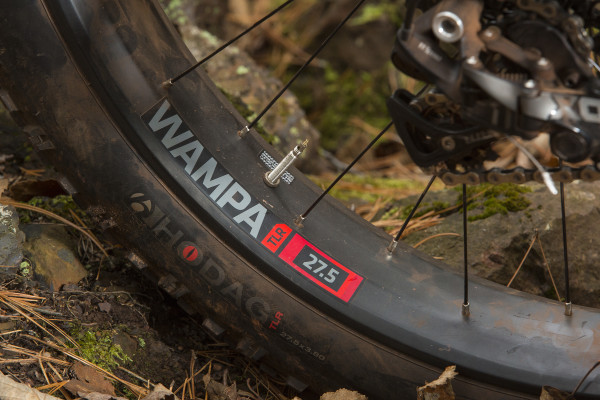
A Wampa is an ice creature from the now slightly well-known Star Wars series. Hodag is taken from a folkloric animal said to be discovered in Wisconsin, oddly close to Waterloo. I applaud Bontrager for strutting some soul in the naming of their winter fat-bike components. It’s fun, and that’s what fat-biking is all about.
Image may be NSFW.
Clik here to view.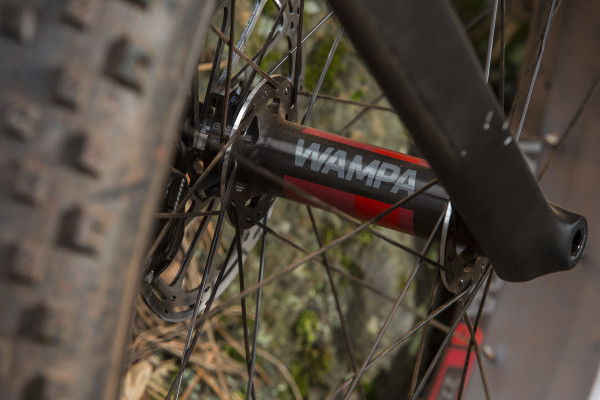
Downhill.
I love a fat-bike on a downhill. I’m not talking about a downhill course riddled with cliffs, boulders, and drops. That would kill me. I’m talking about a good gravity based downhill flow trail. Solid and loose dirt, roots, rocks, a porcupine every once in a while. I never once thought about this bike on the downhill, meaning, I was instantly engaged with it. It made sense, it worked, I don’t think I have to over explain this, you’ll like it.
Clik here to view.
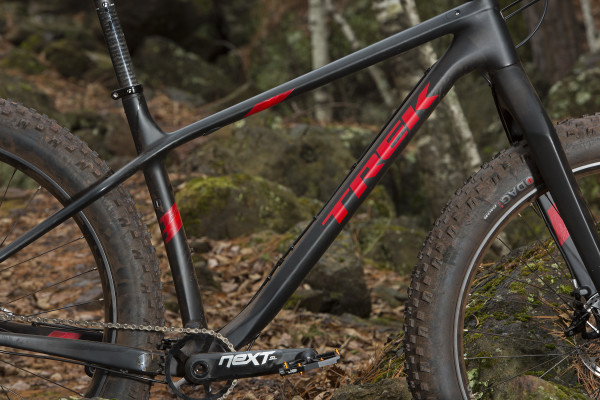
Shown here you can see the pleasing amount of “edge” Trek brings to their Farley 9.8 carbon frame. Gone are the days of a fat-bike frame looking like a noodle, or a goo-monger. The design and aesthetic of the Farley 9.8 strangely ain’t fat. It’s too good looking for that name to be hung around its sculpted neck. As tight as the frame design looks, the ride quality is equally tight. It’s solid, perhaps even more solid and rigid than any carbon frame I’ve experienced to date.
Image may be NSFW.
Clik here to view.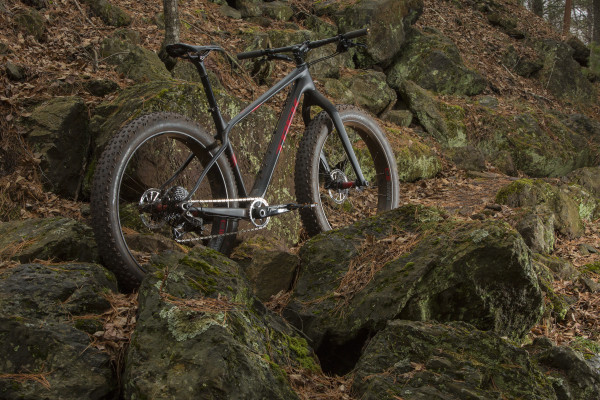
Clik here to view.
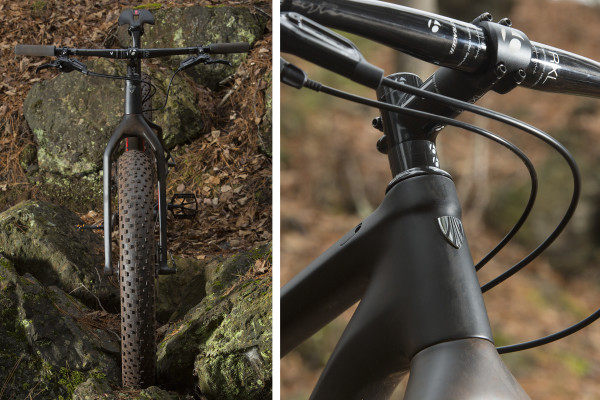
Carbon rims. Carbon fork. Carbon steerer tube. Carbon bars. Carbon spacers. Carbon cranks. Carbon front triangle. Carbon seat stays. Carbon head set. Carbon seat post. Carbon saddle rails. Aluminum stem. Dang! We were on such a good roll there!
Cornering.
I sold my full-suspension 29er because my fat bike of choice out cornered it. On a popular smart phone app my 29er was generally a few seconds faster in terms of start/finish time to my fat-bike, but the 29er couldn’t hold a candle to the amount of cornering fun the fat-bike provided. When I saddled up the Farly 9.8 I was immediately anticipating that same level of cornering ability.
It wasn’t the same.
I had to talk to quite a few people about this. Some folks told me this is how a new fat bike handles, it’s more mountain bikie (Bikie is a term I guess and I just bought a new fat bike last year, it doesn’t handle like this.) I remember the early days of fat-biking when releasing some grip on the handlebars the wheel/tires would auto-steer me around the corner. Truthfully, I never minded that. So, perhaps this is my problem.
To state it candidly, in my opinion and YMMV the 27.5 Farley 9.8 did not possess the cornering ability of other fat-bikes I’d list as “the fat-bike godfathers of corning.”
Over the course of a few months of riding I did adjust my riding style/body position to gain a better cornering experience. I discovered getting my butt and weight off the back of the saddle in the corners and tipping my hips allowed the bike to carve a preferable line. Once I was accustomed to it, it worked, it was fine, it was just an added “to-do” versus how I turn my daily fat-bike (I simply lean, even with butt on saddle). I think what this body language did on the 9.8 was get the tire to finally get over on edge. With the additional height of the 27.5 wheel, turning over the tire on the sidewall took a different/even more aggressive riding style.
Having tested the Hodag prior, I also wonder about the correlation between the tire’s tread pattern and my cornering experiences. I wish the Hodag had one revision for summer riding — A taller, more aggresive sidewall tread lug for the front tire. In my opinion a more aggressive sidewall tread would allow the tire to bite into our red dirt on the single-track giving the front tire the “grip and rip” luxury I have become accustomed to. As there were no other 27.5″-3.8″ tires to test at this time, I can’t guarantee this would work. It would just be my first suggestion.
Clik here to view.
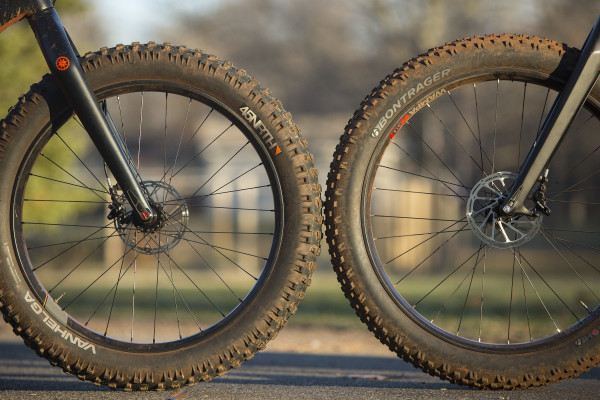
As the discussion is a visual one, here’s a photo to illustrate. On the left a 26″-4.0″ fat bike wheel and tire. On the right, the Farley 9.8’s 27.5″-3.8″ wheel and tire. As shown in the photo the 27.5″ wheel (right) does increase the overall outer height of the Farley 9.8 wheel/tire to approximately 29.375″. (Not a scientific measurement) The traditional 26″-4.0″ (left) measures up at 29″ top to bottom on the outer height of the wheel/tire.
Ride Quality = Rigid+
I’ve been known to keep my fat tires inflated at a higher PSI than most and not mind the chatter. However, with the 9.8 I couldn’t take the beating. I quickly reduced the PSI to 15 rear, 10 front then 8 rear, 6 front. At the lower PSI the bike started to provide a better “suspension effect” through the fat tires, but not to the level I’m accustomed to in a 26″-4.0″ tire inflated to 15 rear, 10 front. The only factor I can conclude is the difference in wheel size (27.5″ vs 26″) and tire size (3.8″ vs 4.0″) reduced the “suspension effect” due to a larger circumference of the wheel and the reduced amount of tire around that larger wheel. I’d love to ride this bike with the spec 26″ Bontrager wheel and tire set for a compare and contrast point of view. Not only in terms of ride rigidity, but in terms of cornering.
The other item that is unconventional to most carbon frames is carbon has typically dampened the ride harshness quite a bit, especially with a carbon frame and wheel. However, here again, perhaps the OCLV carbon has less flex than the other carbon I have become adjusted to riding on. I’m not saying it’s bad, I’m only pointing out it’s different. If this was my only bike, I’d quickly come to know it and be accustomed to it within 3 rides. I know from the original Farley, Trek’s desire was for a fast fat bike. Race-like in nature. That means stiff.
Strangle Hold Dropout.
This feature is worthy of an Interbike award. What’s amazing about the Strangle Hold Dropout is when you adjust the placement of the rear axle the disc brake mount moves with it. Again, someone in engineering deserves an extra week of vacation. The rear of the frame certainly allows the precious room for the larger tires for the winter white season and I hope someone is sending those my way to test on our groomed single-track. The Strangle Hold Dropout also reminds me a downhill ski bindings when you could slide them forward for aggressive shredding, middle for easy going, and rear for powder. Seemingly similar in the fat-bike world. It’s impressive as it allows for that potential one-bike quiver. The summer dirt shredder and the winter corduroy carver. 3 different wheel sizes, 1 bike. The combinations are endless for those of us who love options.
Image may be NSFW.
Clik here to view.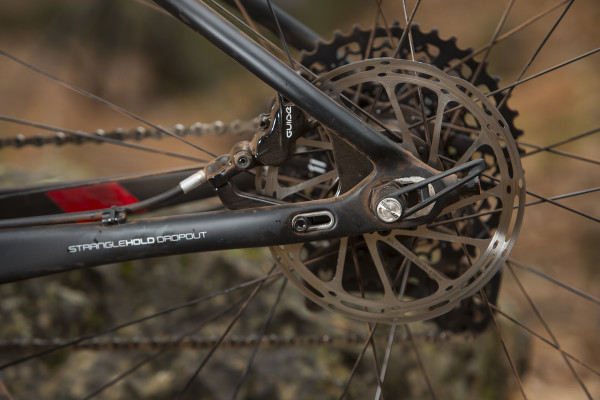
Image may be NSFW.
Clik here to view.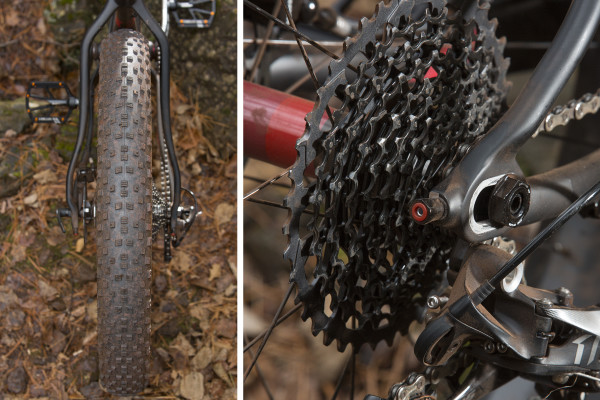
Saddle up.
The Bontrager Montrose Pro saddle. Weight-shaving galore and carbon rails to boot. Great looking saddle but it wasn’t right for me. YMMV. I couldn’t ride this saddle two days back to back. Well, I could, I just had to stand up on my pedals on the second day because sitting down was just too painful in all the unmentionable areas. You have to admit it’s a very cool looking saddle though. But when it comes to a saddle, I have to elect for “function” over “form” and to date WTB has me at hello with their Silverado series.
Image may be NSFW.
Clik here to view.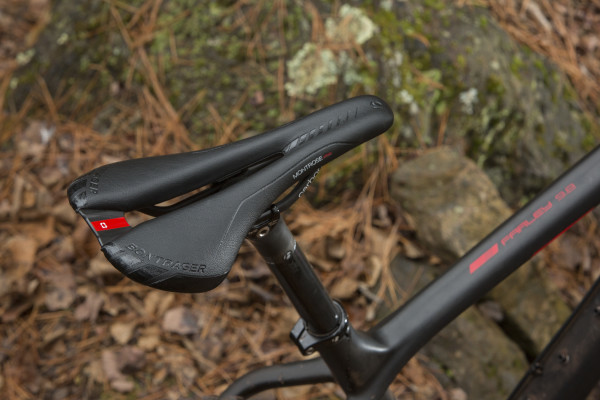
Parting thoughts.
The Farley 9.8 is a great bike. It’s different than what I would have expected in terms of cornering and rigidity, but all in all, Trek threw their entire engineering team into developing not just a fat-bike, but a fat-bike that once again pushes this industry and segment forward. All of us as riders will benefit from this.
I applaud their effort. I’d love to see a different and slightly wider tire become available for summer shredding which could remedy the cornering issues that I experienced. Another consideration for an up and coming Farley 9.9 in the future would be the new Trek ISO Speed decoupler. This could come in handy for summer shredding to smooth out and make the dirt riding more comfortable. In the winter, rigidity isn’t going to be an issue, snow has a wonderful way of smoothing out the trail surface.
Other parting thoughts are 9.8 is DI2 electronic drivetrain capable. So if you have the money, Farley has the way. It’s also dropper post ready. I hope you see by now Trek basically thought through almost every possible scenario.
I look forward to the snow. Here in Minnesota our winter is still not here. The pictures shown here are our current winter appeal, minus a little bit of snow slush that still lingers from our one snowfall we received a week ago. I look forward to these larger rims on groomed single-track. I look forward to sharing with you all the results. I look forward to just riding a bike. It’s a serious joy.
Until then, ride happy.
Clik here to view.
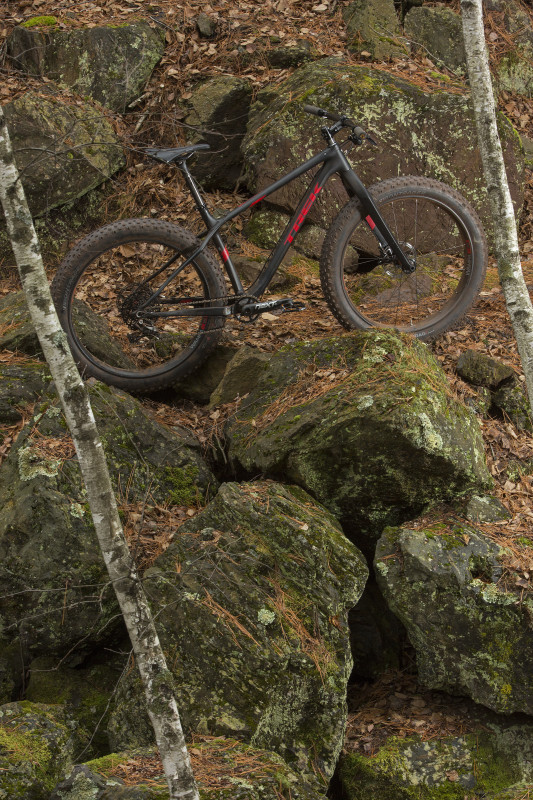
The Farley 9.8 stands atop rocks that were blown out of the ground via dynamite and a mining industry that fueled the United States through World War 1. Seriously nice rocks for central Minnesota.